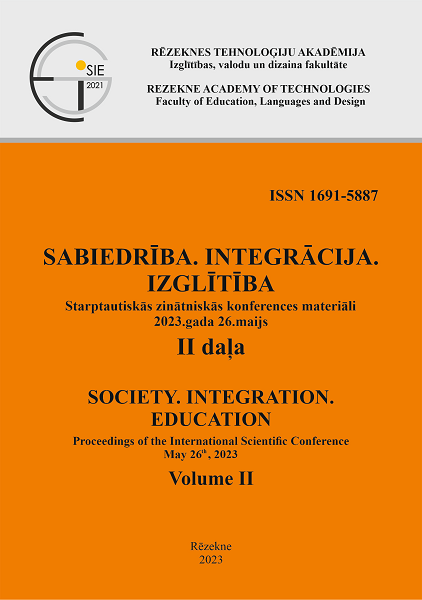THE PROBLEM OF ADAPTATION OF PRESCHOOL CHILDREN FOR A PRESCHOOL INSTITUTION
DOI:
https://doi.org/10.17770/sie2023vol2.7145Keywords:
adaptation, adaptation structure, indicators of adaptation, preschool childrenAbstract
The problem of adaptation of the child in kindergarten is still rather relevant. Despite the fact that the issue was raised by the classics of preschool pedagogy and psychology (Rubinshtein, 1957; Aksarina, 1977; Bure, 2014; Bozhovich, 1967), there are currently no answers to several important questions related to adaptation in general and to the adaptation of children. This is due to the complexity and diversity of the adaptation mechanism inherent in all living beings. The process of adaptation studied by different sciences affects different levels of adaptation to changing environmental conditions: from cells to society.
In relation to a preschool child, it is important to determine the structure of the adaptation process, including such diverse phenomena as the nature of sleep, nutrition, health indicators, emotional state, as well as attitudes towards relatives and alien adults and children, the ability to actively act in a new social environment. The idea of this study grew out of the need to hierarchize the child's individual ways of responding to a new environment and to determine the sequence and timing of normative adaptation. Currently, there are very different assessments of the ability of a preschool child to be included in a social environment that is conditionally unfamiliar to him.
Firstly, most authors consider the adaptation period to be extremely painful and difficult for a child, in which he is able to receive a load of difficult experiences and health disorders. The severity of the process is often estimated by the level of morbidity in children during the period of adaptation. Secondly, the course of the adaptation process itself is determined from 2 weeks to six months. Also, the specifics of children of different ages getting used to kindergarten, as well as the time when the beginning of his attending is the most favorable, has not been studied.
The aim of the study is to determine the structure of the process of adaptation of children of primary preschool age in a kindergarten.
References
Aksarina, N. M. (1977) Vospitanije detei rannego vozrasta.-M., Medicina, 301 s.
Alsberga, M., Antiņa, I., Dortāne, R., Frolova, I., Helmane, I., Jonīte, V., Līne, A., Milaša, M., Paisuma, K., Platnova, J., Prole, A., Šnepere, L., & Volāne, E. (2016). Metodiskie ieteikumi Pirmsskolas mācību programmu īstenošanai. Valsts izglītības un satura centrs. ISBN 978-9934-540-08-0. 4 -5.lpp
Bozhovich, L. I. (1967). Formation of personality in a team. In: L. I. Bozhovich, L. V. Blagonadezhina. Issues of Psychology: the thirteenth year of publication. Ed. A. A. Smirnov, V. N. Kolbanovsky. - No. 3 May-June 1967. - p. 144-152.
Bozhovich, L. I. (2008). Personality and its formation in childhood. - St. Petersburg.: Peter, - 398 p..
Brown, J. (2020). Kindergarten without tears – what should parents know about the adaptation period?. Retrieved from: https://findmykids.org/blog/en/kindergarten-adaptation-period
Bure, R. (2014) Social and moral education of preschoolers. For classes with children 3-7 years old. GEF. Mosaic-Synthesis.
Dikaya, L. G. (2007). Adaptation: methodological foundations and main areas of research In: L.G. Dikaya. Psychology of adaptation and social environment: modern approaches, problems, prospects, Per Se, - S. 17-42.
Gailuma, S. (2002). Mazbērnu adaptācijas process pirmskolā. In: Red. D. Dzintere. Bērns kā individualitāte pirmsskolas izglītības iestādē.
Lebedinsky, V. V., Nikolskaya, O. S., Baenskaya, E. R., & Liebling, M. M. (1990) Emotional disorders in childhood and their correction. Moscow, MGU, 1990. Retrieved from: https://www.studmed.ru/lebedinskiy-v-v-nikolskaya-o-s-baenskaya-e-r-libling-m-m-emocionalnye-narusheniya-v-detskom-vozraste-i-ih-korrekciya_ad44e981f1d.html
McLean, S. (2016). The effect of trauma on the brain development of children. Evidence-based principles for supportingthe the recovery of children in care. Retrieved from: https://www.researchgate.net/publication/311223824
Official statistics of Latvia. (2001). Pre-school education. Retrieved from: https://stat.gov.lv/lv/statistikas-temas/izglitiba-kultura-zinatne/pirmsskolas-izglitiba
Puškarevs, I. (2001). Attīstības psiholoģija: RaKa, 2001. 88 lpp.
Romenkova, V. (2008). Bērns ģimenē un sabiedrībā. BJC "Rīgas Skolēnu pils", BJC "Rīgas Skolēnu pils", 2008. -76 lpp.
Rubinshtein, S. L. (1957). Social being and consciousness, - M., 1957.
Tonkova-Yampolskaya, T. Y., & Chertok, I. N. Alferova (1993). Fundamentals of medical knowledge: Textbook. allowance for ped. colleges on special. "Preschool education", 3rd ed., finalized. - Moscow: Enlightenment.
Vorobjova, A., (2022). 1.posma vecuma bērniem veiksmīgās adaptācijas nosacījumi pirmsskolas izglītības iestādē. Kvalifikācijas darbs. LU.
Wall, L., Higgins, D., & Hunter, C. (2016). Trauma-informed care in child/family welfare services (CFCA Paper No. 37). Melbourne: Australian Institute of Family Studies.






